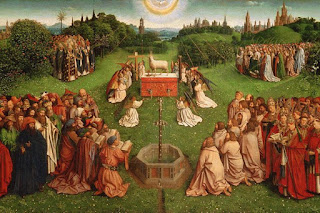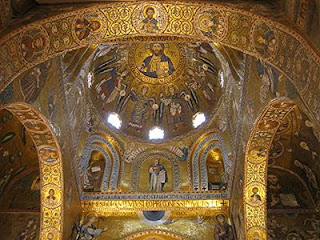One of the main themes of the Constitution on the
Sacred Liturgy (SC) from the Second Vatican Council was full, active, conscious
participation in the liturgy. Consider
the following quote from the Council:
Mother Church earnestly
desires that all the faithful should be led to that fully conscious, and active
participation in liturgical celebrations which is demanded by the very nature
of the liturgy. Such participation by the Christian people as "a chosen race,
a royal priesthood, a holy nation, a redeemed people (1 Pet. 2:9; cf. 2:4-5),
is their right and duty by reason of their baptism. (SC 14)
The very nature of the liturgy demands this kind of
participation, and our right to participate in this way flows from our
baptism. So much was this a concern,
that the council called this kind of participation in the Liturgy its primary
aim:
In the restoration and
promotion of the sacred liturgy, this full and active participation by all the
people is the aim to be considered before all else; for it is the primary and
indispensable source from which the faithful are to derive the true Christian
spirit; and therefore pastors of souls must zealously strive to achieve it, by
means of the necessary instruction, in all their pastoral work. (SC 14)
This wasn’t the first time the Church had talked
about active participation in the Liturgy by all the faithful. Sixty years prior, Pope Pius X was calling
for the same thing:
Filled as We are with a
most ardent desire to see the true Christian spirit flourish in every respect
and be preserved by all the faithful, We deem it necessary to provide before
anything else for the sanctity and dignity of the temple, in which the faithful
assemble for no other object than that of acquiring this spirit from its
foremost and indispensable font, which is the active participation in the most
holy mysteries and in the public and solemn prayer of the Church. (Tra le
Sollecitudini, Instruction on Sacred Music, Pope Pius X, November 22, 1903)
The question arose after the Council, however, what
is meant by full, active, conscious participation in the liturgy? Not everyone agreed, and this meant
variations in practice at Sunday Masses.
Pope Benedict XVI has written:
“But what does this
active participation come down to? What
does it mean that we have to do?
Unfortunately, the word was very quickly misunderstood to mean something
external, entailing a need for general activity, as if as many people as
possible, as often as possible, should be visibly engaged in action. (The Spirit of the Liturgy, 171).
No, this active participation does not necessitate
that we’re all doing something external throughout the liturgy. Certainly, some of these external actions
(gestures, postures, responses, etc.) manifest active participation:
To promote active
participation, the people should be encouraged to take part by means of
acclamations, responses, psalmody, antiphons, and songs, as well as by actions,
gestures, and bodily attitudes. And at the proper times all should observe a
reverent silence. (SC 30)
Notice, however, that silence is listed as a means
of active participation! While outward
manifestations are helpful, the primary notion of full, active, conscious
participation in the Liturgy is our interior participation:
But in order that the
liturgy may be able to produce its full effects, it is necessary that the
faithful come to it with proper dispositions, that their minds should be
attuned to their voices, and that they should cooperate with divine grace lest
they receive it in vain. Pastors of souls must therefore realize that, when the
liturgy is celebrated, something more is required than the mere observation of
the laws governing valid and licit celebration; it is their duty also to ensure
that the faithful take part fully aware of what they are doing, actively
engaged in the rite, and enriched by its effects. (SC 11)
Hence, the vision of Vatican II and its restoration
of the Liturgy was not some sort of frenetic attempt at including everyone in
outward action at all times. Truly full,
active, conscious participation means the work of forming ourselves to
understand the meaning of the Liturgy and the (sometimes difficult) work of
attuning our hearts and minds to the actions unfolding at the Liturgy. After all, it’s one thing to sing the
response, Hosanna in the Highest; it’s another thing to know what Hosanna
means. One is simply activity. The other is full, active, conscious
participation.







